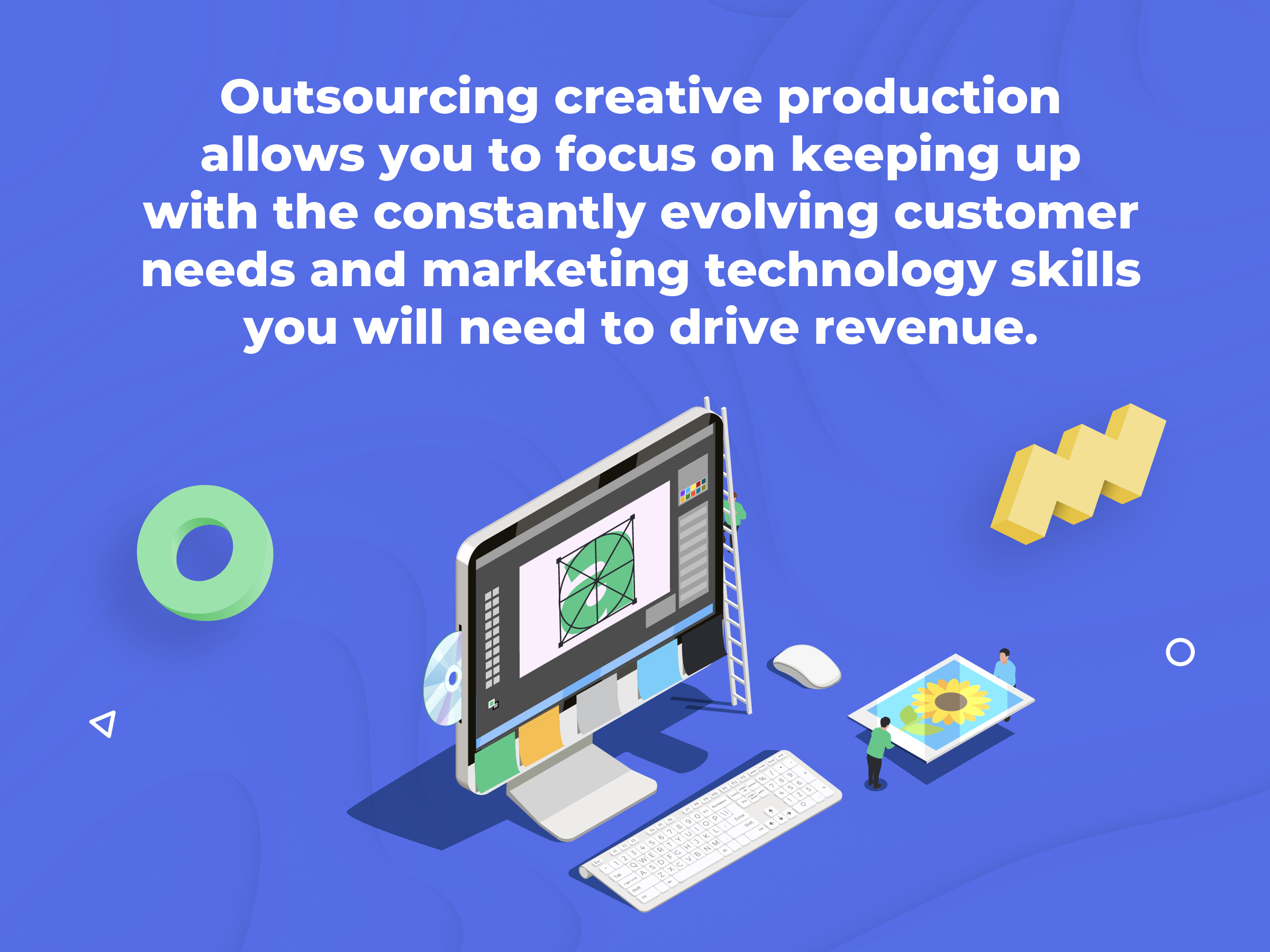Marketing is constantly evolving. Just think, a few decades ago email didn’t even exist. Many of the strategies marketers take for granted today were completely nonexistent in the not-so-recent past. With expectations continually changing, today’s marketers know that they have to innovate and adapt to constantly keep up with the times.
Read on to discover how your marketing department can meet increasing expectations without increasing costs by outsourcing your creative production needs. And for additional insight, download The Revenue Marketing Playbook.

New Marketing Technologies Are Emerging All the Time
Marketing only became an essential part of business operations in the 1960s. In this era, markets were becoming more crowded, and companies needed to demonstrate their advantage over the competition — which is where marketing came into play. But in this pre-internet era, marketing was a completely different world.
It wasn’t until the 1990s that Bristol Myers Squibb launched the first online marketing campaign for their migraine medication, Excedrin Migraine. Even though it was just a basic text-based website, this campaign’s success ushered in the dawn of a new digital marketing era.
Today, we’ve come a long way from simple text-based websites, and marketing is arguably more complicated than ever before. As technology continues to evolve, marketing departments must add more functionality to keep up with the competition. In fact, there are over 8,000 tools available for your marketing technology stack, a number that is growing all the time.
In 2020, data-focused technologies stood out among the ever-expanding roster of marketing tools, having grown 25.5% since 2019. When you think about the upwards of 2.5 quintillion bytes of data created every day, it makes sense that data analysis reigns supreme.
But that’s not all. New marketing technologies are also emerging in artificial intelligence, SEO, and conversational marketing, like chatbots, to name a few.
As new technologies like these are created and adopted by more and more marketers, the pressure is on. Marketers might feel obligated to add each new technology to their marketing technology stack to fear falling behind their competitors.

Increasing Expectations is the New Normal
Of course, the COVID-19 pandemic has further increased the necessity for marketing technological evolution. With today’s economic downturn and the unprecedented change in the way we all live and work, marketing departments cannot afford to fall behind.
Marketers expect that these unprecedented times will have a lasting effect on consumers. For one thing, consumers have already gotten used to a more seamless integration between online and offline processes. In the future, consumers will continue to expect fast delivery times at the touch of a button.
Plus, as more people adapt to working from home, consumers are inundated with online advertising at a higher rate than ever before. This ratchets up the competition for companies today — it’s harder than ever to stand out among the competition online.
During the uncertainty of the COVID-19 era, it might seem like a crystal ball is the only thing that could guarantee a successful marketing campaign. Instead, marketing departments are investing in the next best thing: data-driven marketing strategies.
With up-to-date consumer insights, marketers can more effectively build their campaigns around what their consumer base wants. Then, they can more quickly respond to the curveballs of the COVID-19 era. In fact, data-driven marketing campaigns are becoming a necessity. Today, 72% of consumers will only respond to marketing messages specifically tailored to their interests.
Marketing has always been an industry that is quick to innovate. But the COVID-19 pandemic has accelerated everything to the tune of 10 years’ worth of change in a matter of months. So what can a marketing department do to stay cutting-edge during these times?

How to Meet Expectations Without Increasing Costs
With expectations for marketing departments and their technological capabilities reaching new heights, what can be done to increase your marketing department’s flexibility without any increase in your budget?
As the market and consumer behavior fluctuate, you have to be ready to change course at a moment’s notice. This means your marketing department should be as lean and flexible as possible. But how can you do this without making huge sacrifices? It’s simple — in theory, at least. Any functions that distract from this overarching goal should be outsourced to save managerial time and money.
Think of all the functions your marketing department fulfills in-house. There’s a good chance that not all of these functions are contributing to your competitive advantage. If you isolate these time-consuming, low-level functions and outsource them to a subscription workforce, you can increase your flexibility without increasing costs. In fact, you will likely save 50% to 70% in payroll expenses and free up managerial time that can now be spent on more deeply understanding your customers.
With a subscription workforce taking care of these functions, you get the benefits of expert-level work at a fraction of the cost of hiring an expert in-house.
Plus, a subscription requires less commitment than hiring an in-house employee so that you can say goodbye to contracts and hidden fees. With subscription-based graphic design, you can customize your workforce to suit your needs, giving you the flexibility you need during uncertain times.

Outsource Creative Production
So far, we’ve discussed the increasing demands marketing departments face and how COVID-19 has accelerated them. Then, we laid out the benefits of a subscription workforce and discussed how a subscription workforce can increase your flexibility.
But what does this look like in practice? And how do you know which particular functions would be ideal for outsourcing?
Graphic design is the perfect place to start. Professional graphic design is essential to any marketing campaign. After all, eye-catching design helps draw attention to your brand online.
But more than that, a subscription workforce like Design Pickle has the power to help you drive revenue growth for your marketing department. How? By outsourcing creative production, you’ll have the capacity to spend more time on the tasks that build your competitive advantage. With design off your plate, you can focus on keeping up with the constantly evolving customer needs and marketing technology skills you will need to drive revenue.
Looking for more marketing insights? Download The Revenue Marketing Playbook to discover an in-depth explanation of the benefits of a subscription workforce for graphic design and how it can help you stay competitive in uncertain times.






